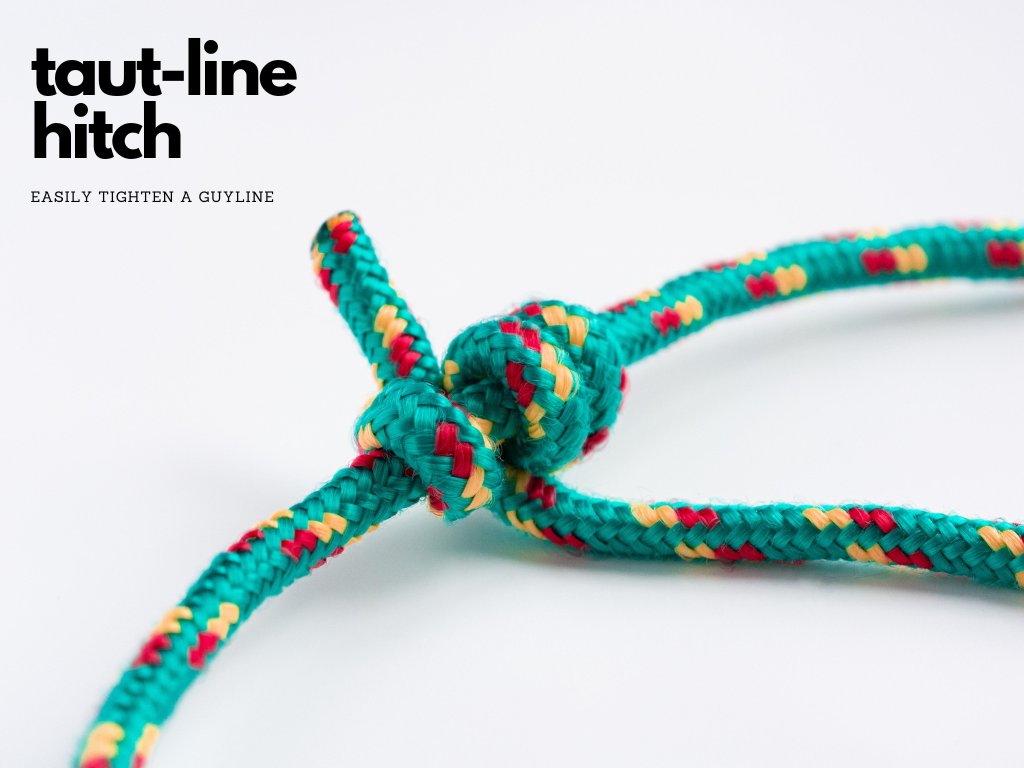Knots do not come naturally to me. Luckily, for those of us who find knots challenging, you only need a few to get by. My choices for the best camping knots are the bowline, trucker’s hitch, taut line hitch, and double fisherman’s knot. I use them almost every trip for setting up tarps, securing my canoe, tying down guylines, and elevating a bear bag.
I’ve found the key to learning knots is patience and using multiple sources. Sometimes, after much struggle, one person will explain a knot in a way that finally clicks with you. This post links you to some of the best online sources for learning these four camping knots and discusses their uses, strengths, and weaknesses.
Bowline
Uses: Anchor for a ridge line, rescue situations, securing a loop at the end of a rope, staking out a tent

The bowline is considered one of the most important knots because of its versatility and ease of use (you can learn to tie it with one hand!). The knot is used to create loops at the end of a rope which won’t slip under tension.
When camping, it’s great for anchoring one end of a ridge line, tying off a bear bag, or securing a canoe to the shore. This knot is also used in rescue situations as the loop can be slipped over a person and under their arms.
Strengths: Reliable under a load, easy to tie, easy to untie after being under tension.
Weaknesses: Can become loose when not under a load/tension.
How To Resources:
NightHawkInLight – How to Tie the Most Useful Knot in the World (Bowline)
Wikipedia Image – Tying a Bowline
Outside Chronicles – 10 Uses of the Bowline Knot
Trucker’s Hitch
Uses: Creating taut ridgelines, securing guylines, securing a canoe or kayak to a car

The trucker’s hitch is a useful knot for setting up ridgelines for tarp suspension. It makes a taut line that is secure and easy to adjust. This hitch has many variations depending on how you form the fixed loop and finish the knot. I use a directional figure-eight for the loop and two half-hitches to finish the knot (see: Animated Knots). Others use a slip-knot and halter-hitch for quick release (see: The Prepared).
In addition to setting up ridgelines, I use the trucker’s hitch to make a running line for my dog at campsites. I also use it for tying the front and back ends of my canoe to my car. Some people also use this hitch for guylines.
Strengths: Mechanical advantage for tightening lines and easy to adjust.
Weaknesses: Friction from tightening will reduce the strength of your rope over time. If your line is attached directly to a tarp, pulling too tightly could cause a rip.
How To Resources:
The Prepared – How to Tie Truckers Hitch Survival Knots
Animated Knots – Trucker’s Hitch
REI – How to Tie A Trucker’s Hitch
Stephen Stanley – How to Tie a Trucker’s Hitch to Secure a Kayak
Taut-Line Hitch
Uses: Easily tighten a guyline, create a ridgeline

The taut-line hitch is my go-to for tying down tent and tarp guylines. This hitch is very easy to adjust without having to untie anything. It can also be used for a ridgeline, but I find the trucker’s hitch easier to tighten for that purpose.
Strengths: Very easy to adjust without any untying.
Weaknesses: Not the best for larger climbing ropes, but works well with smaller ropes.
How To Resources:
Jason’s Knot Channel – How to Tie the Taut Line Hitch
Howcast – How to Tie a Taut Line Hitch Knot
Double Fisherman’s Knot
Uses: Connect two ropes together, make a lanyard

The double fisherman’s knot is my favourite knot for connecting two pieces of rope together. It’s very strong, but the ropes need to be around the same diameter for it to be effective. This knot is sometimes called the “impossible knot” because, though very strong, it is near impossible to untie when it has been under a lot of tension.
Strengths: Easy to tie and very strong.
Weaknesses: Can be difficult or impossible to untie after being under tension.
Useful Resources:
Paul Kirtley – How to Tie a Double Fisherman’s Knot
Animated Knots – Double Fisherman’s Bend
REI – How to Tie a Double Fisherman’s Knot
I’m So Frustrated With These Knots!
Ugghhh! You can’t figure these knots out. Trust me, I’ve been there! I don’t think there is an easy way other than failing over and over again. If you have a friend who knows knots, get them to help you out. Or, try an in-person knot tying course. I’ve taken them at Mountain Equipment Coop and seen them advertised at local outfitters and outdoor groups.
Once you do nail a knot (and you will!), practice regularly so that you don’t lose the skill. There have been so many times that I’ve forgotten a knot because I hadn’t practiced. Now, I keep a few short ropes near my television so that I don’t forget to practice.
What Makes a Good Knot?
Ultimately, the best knot is the one you know and will work for your purpose. Once you learn a few knots, it becomes easier to learn others. Soon you’ll be a knot nerd and you can debate your friends on which one is best for what application.
In general, a good knot will hold its shape, won’t slip, is fast to tie, and easy to undo. You’ll also notice that some knots take a lot more rope than others.
What Are Your Top Camping Knots?
I’d love to hear your favourite camping knots! Leave me a message in the comments section.
Other Posts You May Enjoy
Where to Learn Outdoor Skills in Canada